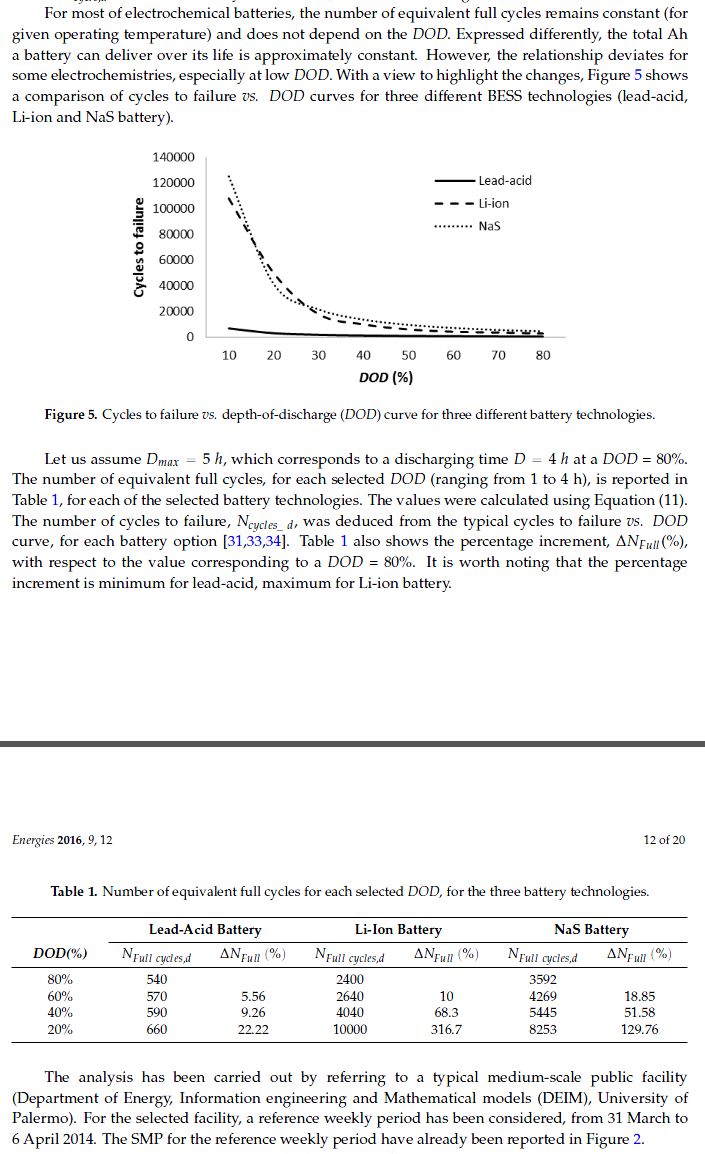I noticed the same thing in "cycle count". hat drives me crazy is that people do not write perfectly clearly, and often leave one to wonder [...]
Such studies usually measure in terms of "equivalent full cycles", e.g. 2 discharges of 50% capacity (DOD) are counted as equivalent to 1 full cycle, as are 4x 25% discharges, etc.
It is not so well-known that Li-ion cells behave very differently than lead-acid cells when it comes to partial discharges. Namely they are much more sensitive to the depth of the discharge, and to the region in which it occurs. Generally, discharges that are lower depth, and more balanced around 50% capacity will prolong lifetime - possibly by large amounts.
Below is an example from
Energies 2016, 9(1),12; doi:10.3390/en9010012, E. Telaretti et al. Here DOD means Depth Of Discharge. So a 25% DOD means a discharge of 1/4 of the capacity of the cell.
The prior table shows that decreasing the discharge depth from 80% vs. 20% yields 4.2 times the lifetime (10000 vs. 2400 cycles) for their Li-ion cells. But the corresponding lead acid gains are much smaller, about 1.2 times the life.
There are more precise studies, e.g. the graph below, from Ecker et al.
Calendar and cycle life study of Li(NiMnCo)O2-based 18650 lithium-ion batteries,
Jnl Power Sources 248 (2014) 15, 839-51, which shows the dependence on both the depth of discharge and its distance from center = 50% SOC (here SOC = State Of Charge, e.g. 50% S0C means 50% of capacity, i.e. half full).

The leftmost column of data points are for very short discharge cycles of depth 5% (of capacity). The lowest 2 points (green and brown overlapping points) at (x,y) = (5%,2000) show that they obtained the equivalent of about 2000 full cycles when the discharge was centered at 75% SOC (green curve) and 90% SOC (brown curve). Moving up to the blue point at about 5800 we see that they got almost 3x as many full cycles by shifting the discharge center point to 25% SOC, i.e. one-fourth capacity. The topmost purple point shows they got about 8500 full cycles by shifting the center of discharge to 50% SOC. So shifting the discharge center point to 50% SOC (vs. 75% or 90%) yields more than a factor of four (4.3) times increase in the number of full cycles, i.e. 8500 vs. 2000 full cycles. This shows how balancing discharges around 50% SOC may yield large gains in life. Similar remarks hold for the next two columns of points representing discharges of depth 10% and 20%.
The rightmost purple data point corresponds to full discharges (100% DOD). They yield under 500 full cycles, more than 17 times fewer than the 8500 equivalent full cycles obtained at 5% DOD centered at 50%.



